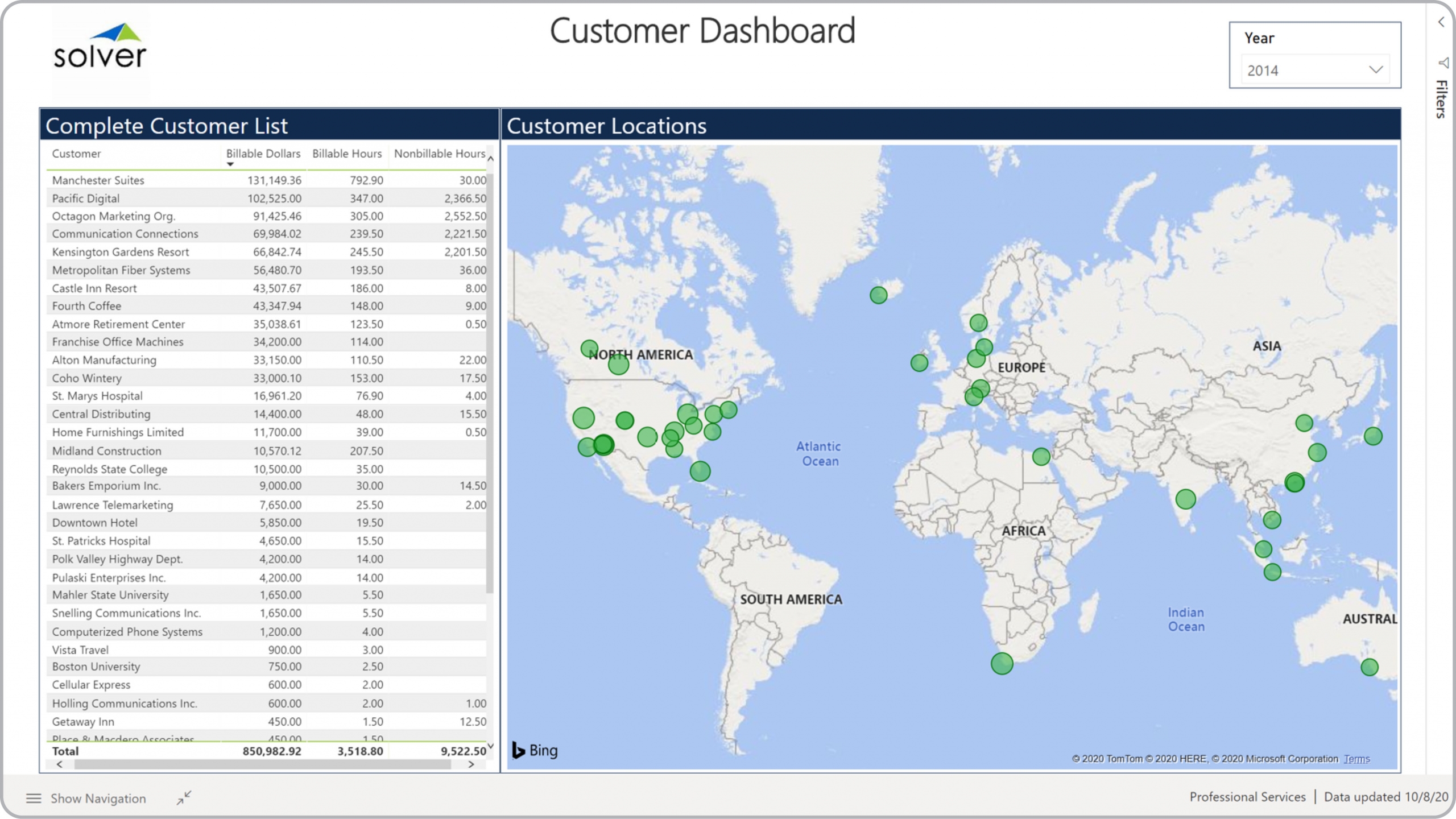Customer Billing Dashboard for Professional Services Companies
What is a
Customer Billing Dashboard
? Customer Billing Dashboards are considered client analysis tools and are used by executives and project managers to review revenues and hours by client and location. Some of the main functionality in this type of dashboard is that it provides analysis from these two major perspectives: 1) Customers ranked by billable amount and with billable hours and nonbillable hours, and 2) Customer locations (note that the size of the markers can be set to correspond to e.g. the billable amount for each customer). The user can choose year with the drop down filter on the top of the screen. You find an example of this type of dashboard below.
Purpose of
Customer Billing Dashboards Professional service organizations use Customer Billing Dashboards to gives managers an easy way to see which customers are providing the most revenues , or reversely - nonbillable hours, and if there are any patterns related to geographical customer location. When used as part of good business practices in Financial Planning & Analysis (FP&A) and Consulting departments, an organization can improve its customer strategies and increase revenues, and it can reduce the chances that important trends are missed with resulting impact on margins..
Example of a
Customer Billing Dashboard Here is an example of a Customer Billing Dashboard with billing and hourly metrics as well as geographic location displayed on a map.
 You can find hundreds of additional examples
here
Who Uses This Type of
Dashboard
? The typical users of this type of dashboard are: Executives, CFOs, consulting managers, analysts, sales managers.
Other Reports Often Used in Conjunction with
Customer Billing Dashboards Progressive Financial Planning & Analysis (FP&A) and Consulting departments sometimes use several different Customer Billing Dashboards, along with profit & loss reports, project dashboards, revenue dashboards, detailed billing and utilization reports, project budget models, billing forecast models and other management and control tools.
Where Does the Data for Analysis Originate From? The Actual (historical transactions) data typically comes from enterprise resource planning (ERP) systems like: Microsoft Dynamics 365 (D365) Finance, Microsoft Dynamics 365 Business Central (D365 BC), Microsoft Dynamics AX, Microsoft Dynamics NAV, Microsoft Dynamics GP, Microsoft Dynamics SL, Sage Intacct, Sage 100, Sage 300, Sage 500, Sage X3, SAP Business One, SAP ByDesign, Acumatica, Netsuite and others. In analyses where budgets or forecasts are used, the planning data most often originates from in-house Excel spreadsheet models or from professional corporate performance management (CPM/EPM) solutions.
What Tools are Typically used for Reporting, Planning and Dashboards? Examples of business software used with the data and ERPs mentioned above are:
You can find hundreds of additional examples
here
Who Uses This Type of
Dashboard
? The typical users of this type of dashboard are: Executives, CFOs, consulting managers, analysts, sales managers.
Other Reports Often Used in Conjunction with
Customer Billing Dashboards Progressive Financial Planning & Analysis (FP&A) and Consulting departments sometimes use several different Customer Billing Dashboards, along with profit & loss reports, project dashboards, revenue dashboards, detailed billing and utilization reports, project budget models, billing forecast models and other management and control tools.
Where Does the Data for Analysis Originate From? The Actual (historical transactions) data typically comes from enterprise resource planning (ERP) systems like: Microsoft Dynamics 365 (D365) Finance, Microsoft Dynamics 365 Business Central (D365 BC), Microsoft Dynamics AX, Microsoft Dynamics NAV, Microsoft Dynamics GP, Microsoft Dynamics SL, Sage Intacct, Sage 100, Sage 300, Sage 500, Sage X3, SAP Business One, SAP ByDesign, Acumatica, Netsuite and others. In analyses where budgets or forecasts are used, the planning data most often originates from in-house Excel spreadsheet models or from professional corporate performance management (CPM/EPM) solutions.
What Tools are Typically used for Reporting, Planning and Dashboards? Examples of business software used with the data and ERPs mentioned above are:
- Native ERP report writers and query tools
- Spreadsheets (for example Microsoft Excel)
- Corporate Performance Management (CPM) tools (for example Solver)
- Dashboards (for example Microsoft Power BI and Tableau)
Corporate Performance Management (CPM) Cloud Solutions and More Examples
May 6, 2021
TAGS:
Reporting,
Solver,
report writer,
Microsoft,
template,
consulting,
customer dashboard,
practice,
Acumatica,
visualization,
customer,
Netsuite,
Finance,
planning,
GP,
dashboard,
Business Central,
excel,
professional,
ax,
forecast,
Budget,
billable hours,
Dynamics 365,
budgeting,
KPI,
Cloud,
Software,
Tableau,
SAP,
example,
best,
Sage,
BC,
location,
D365,
NAV,
Intacct,
services,
professional services dashboard,
CPM,
report,
SL,
Management,
dynamics,
Power BI,
client dashboard,
map

